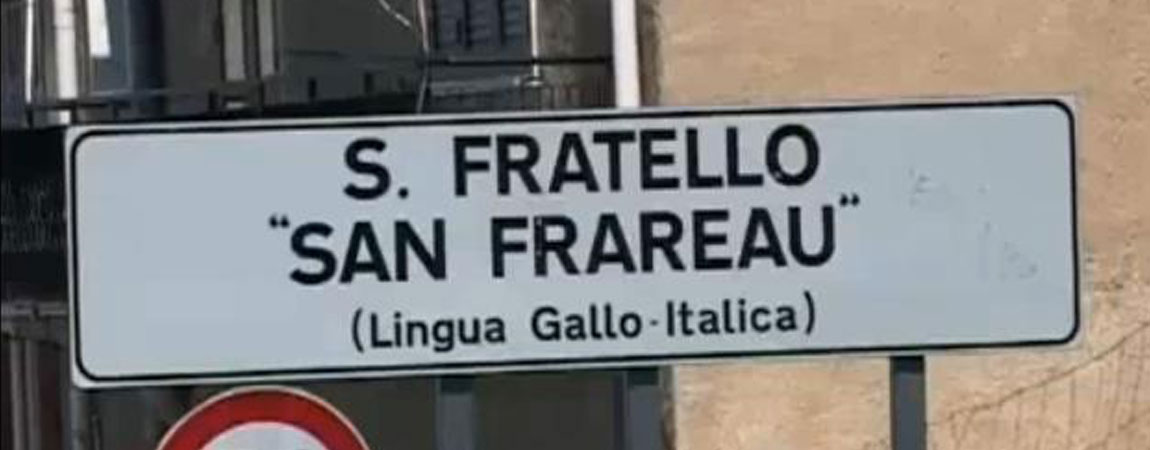
San Fratello is a town of about 4000 inhabitants located on the Nebrodi mountains in the charming province of Messina.
A particularly important area of Sicily because they are in the town Al Pacino's grandparents were born, Craxi's family as well as the famous St. Benedict the Moor. But few know that in San Fratello we talked, and it is still done today, the so-called Gallo-Italian language.
San Fratello: Lombardy Sicily
The concept of how Italy during the nineteenth century and probably still today is often emphasized is not so much for an economic issue as for a cultural one because, according to many scholars, the Kingdom of the Two Sicilies and Naples has nothing to do with with northern Lombardy.
San Fratello in the province of Messina proves just the opposite. A philologist who lived during the nineteenth century by name Leonardo Vigo he told how in these Sicilian areas were spoken of the Italian rooster that is, a language defined as “more unintelligible than the Favella of Satanasso”. It is no coincidence that at the entrance to the town it is remembered as the English Language is Italian rooster. A tradition that was decided to revive through the regional law issued in 2011 to enhance the linguistic heritage of these areas even if the specific tools for their promotion have not yet been foreseen.
The story of the postman of San Fratello
Raffaele Trimarchi is the country postman that every day he has to cover a distance of about 60 km to get from his home. When he first arrived in San Fratello he had no idea that in this area there could be such a particular dialect with a clear northern sound. However, one should not be surprised why historians remember how the community of San Fratello be the most high expression of the so-called Lombard Sicily. A territorial cake that has northern influences and which includes 14 municipalities present not in the province of Messina, but also in Enna.
The peculiarity of these areas is precisely that there are many people who still speak the Gallo-Italic language today as a result of a migration that occurred between the eleventh and thirteenth centuries, i.e. during the rule of the Normans. It was a choice not so much of work and life opportunities as of a clear contrast on the part of the Normans to the Arab presence on the island which was very large in terms of civilians. This politically desired process gave rise to the Gallo-Italic language which was native to Lombardy and some areas of the current regions of Piedmont, Liguria and Emilia Romagna.
The 1922 landslide in San Fratello
La history of San Fratello it is marked by cultural influences that come from distant peoples but also and above all by catastrophic situations such as the landslide which in 1922 caused many problems. The landslide had repercussions from a social and economic point of view with many people deciding to make a life choice by leaving these places forever and going to live in other areas of Sicily or the rest of Italy.
So there were fewer and fewer people speaking the Gallo-Italic dialect but on the other hand there was a strengthening as regards the sense of unity among the true citizens of San Fratello.
A local historian by name Joseph Foti he recounted how at the time only the poorest citizens who could not afford to move and who already spoke Gallo Italico remained in the country. This fact was important because it allowed the characteristics of the dialect to be preserved over the decades without the possible influences of wealthier and wealthier people who could partially change it.
There are several people of local origin but who moved to areas of northern Italy convinced that this language was southern because they had only heard it in San Fratello. However, by better analyzing the characteristics of the language, we can appreciate many elements that refer to the Celtic language with Frenchisms in addition to some Sicilian words.
Today the situation in San Fratello and in other areas where Gallo Italico is spoken is one of progressive abandonment also due to a phenomenon of depopulation for which we are questioning the possible forms of protection of this dialect which, according to research, has around 60 thousands of people who speak it even if not continuously.
Simoninter at Italian Wikipedia, Public domain, via Wikimedia Commons









